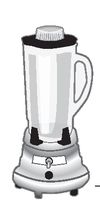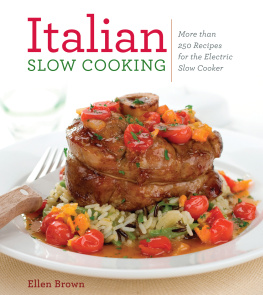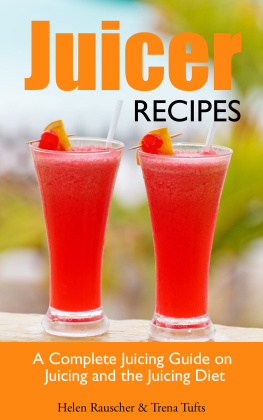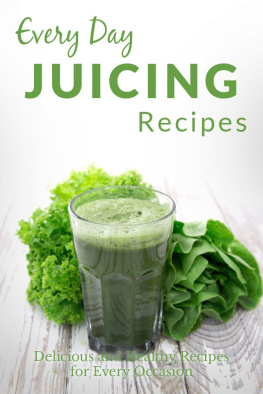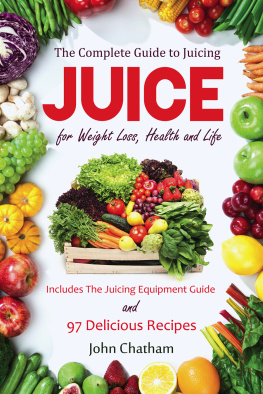Table of Contents
Introduction
Theres nothing new about juicing. Weve given it a snappy handle, but juicings been around for centuries. Drinking the juices of raw fruits and vegetables as a path to good health was even touted in the early nineteenth century.
While juicing itself isnt new, what is new is the machine that can render even the hardest beet into a sweet juice to sip in a matter of seconds. This ability is increasingly important as our society quantifies the amounts of these foods we should be eating. Some governmental agencies say five daily servings of vegetables and three of fruit, while other medical groups advocate seven vegetables and two fruits. Regardless of exact number, its a lot.
Thats where the benefits of juicing begin. An 8-ounce glass of juice can fulfill a third of your daily needs. Its like the difference in medicine between injections and pills. The benefits of the injection go directly into your bloodstream, while a pill must dissolve and be absorbed, which increases the time between when you take it and when you begin to feel the results.
The same is true when juicing because it allows the body to quickly absorb high-quality nutrition, which leads to increased energy levels. So drinking fresh juices is an excellent health habit. Its more than an excellent source of vitamins, minerals, enzymes, purified water, proteins, carbohydrates, and chlorophyll. In liquid form, juices supply nutrition that is not wasted on creating its own digestion, as is the case when eating whole fruits or juices with a large percentage of pulp.
Here are some of the benefits that come from juicing:
Juicing creates fast assimilation of nutrients. Some enzymes, vitamins, and minerals are trapped in the indigestible fiber of vegetables and fruits and can take up to a few hours to be assimilated into the body. When these nutrients are added as a pure juice, the time is reduced to 15 minutes, which allows the body to rest.
Juicing keeps up our water table. Our cells consist mostly of water, which is essential to their proper function. Thats why we should consume at least 8 glasses of water a day. Beverages such as coffee, soft drinks, and alcohol actually draw water from our bodies to metabolize. Raw juices, on the other hand, supply the water we need to replenish lost fluid. And the water is purified better than from any bottle. Juices also promote our bodies natural alkalinity, which is important for immune systems and metabolic functions to work properly.
Juices deliver natural sugar. The natural sugars in fruits and vegetables deliver the same energy as from soft drinks but without chemicals or fat.
You might be wondering why Im asking you to buy an expensive machine rather than just pour from a bottle. Theres an important reason: only fresh juices that havent been pasteurized to increase their stability contain necessary enzymes and other living ingredients.
Plants are the spark plugs that keep our bodies running. They get their energy from the sun during photosynthesis. These living qualities comprise enzymes, vitamins, and minerals. Minerals are basic parts of the earths crust, and plants get them from the soil while enzymes and vitamins are produced in plants tissues.
But cooking and processing destroy these nutrients. Enter juicing as a way to get the maximum benefit. Cooking accounts for the loss of almost all the water-soluble vitamins (A, E, D, and K) from food. And even allowing raw vegetables to sit after peeling reduces their level of nutrients. For example, cantaloupes lose 35 percent of their vitamin C if slices sit overnight in the refrigerator.
So drinking a juice right after its extracted gives you the best of all possible worlds.
How This Book Is Organized
The book is divided into four parts:
Part 1, Component Parts, teaches you the fundamentals of juicing. The first chapter details how to select a juicer, how to use your blender, and the difference between juicing and pulping. In the next two chapters youll find profiles of fruits and vegetables frequently specified in recipes, along with their nutritional highlights and the amount of juice that comes from them. Part 1 ends with a chapter detailing information on nutritional supplements you can add to juices, herbs you can use to flavor them, and ways to use your juice machine as a kitchen tool.
Part 2, Garden Patch Pures, gives you combinations that use just about all the vegetables in the produce aisle. The recipes are divided by both the types of vegetables they contain and if any additional ingredients are added into the flavor profile. In one chapter juices are made primarily from root vegetables, and the next showcases the cabbage and its cousins. The rest of the chapters in Part 2 are for juices complexly flavored with herbs, based on popular cold soups, or balancing fruits with the vegetables.
Part 3, Fruity and Fantastic, shows you that often the whole is better than the sum of its parts. Juice is almost synonymous with fruit, and these recipes multiply the ways you can combine these luscious juices. The recipes in Part 3 are divided by the nature of the predominant fruit in the juice blend. They range from tropical treats to bowls full of bright berries.
Part 4, Lean and Luscious Libations, demonstrates that juices can be fun as well as serious. These juices are meant for parties, either as punches or as cocktails. The recipes in the first chapter of Part 4 are all flavored teas. Some use herbal teas while others encompass many species of prized black tea. In the last chapter of Part 4, youll see some sort of alcohol listed amongst the ingredients, but instructions are given on how to concoct the juices to remain unleaded.
At the end youll find some useful appendixes. A glossary will add to your knowledge of foods, and an appendix of charts will help you convert measurements to the metric system. The last appendix is a chart listing the nutritional composition of the fruits and vegetables frequently used in these recipes.
Extras
In every chapter youll find boxes that give you extra information that is either helpful, interesting, or both.
Juicy Jive
Juicy Jive boxes are where youll find tips. Some are specific to the recipes they accompany; others will boost your general knowledge of juicing and its ingredients or give you ideas for presentation. These tips are meant to make your life easier and your time in the kitchen more pleasurable.
Pulp Tidbits
Check out these boxes for amusing tidbits of food history. Theyre fun to read and share with friends, and theyll make you sound like a real gourmet.





